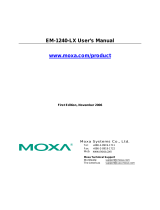
UC-3100 Series Hardware Hardware Connection Description
Wiring Requirements
In this section, we describe how to connect various devices to the embedded computer. You must pay attention
to the following common safety precautions, before proceeding with the installation of any electronic device:
• Use separate paths to route wiring for power and devices. If power wiring and device wiring paths must
cross, make sure the wires are perpendicular at the intersection point.
NOTE: Do not run the wires for signal or communication and power wiring in the same wire conduit. To
avoid interference, wires with different signal characteristics should be routed separately.
• You can use the type of signal transmitted through a wire to determine which wires should be kept separate.
The rule of thumb is that wiring that shares similar electrical characteristics can be bundled together.
• Keep input wiring and output wiring separate.
• We strongly advise that you label wiring to all devices in the system for easy identification.
onnect the power cord before installing and/or wiring the computer.
Caution!
Calculate the maximum possible current in each power wire and common wire. Observe all electrical codes
dictating the maximum current allowable for each wire
size.
If the current goes above the maximum ratings, the wiring could overheat, causing serious damage to your
equipment.
careful when handling the unit. When the unit is
plugged in, the internal components generate heat, and
conseq
uently the outer casing may be hot to touch by hand.
Connector Description
Power Connector
Connect the power jack (in the package) to the UC-3100’s DC terminal block (located on the bottom panel),
and then connect the power adapter. It takes several seconds for the system to boot up. Once the system is
ready, the SYS LED will light up.
Grounding the UC-3100
Grounding and wire routing help limit the effects of noise due to electromagnetic interference (EMI). There are
two ways to connect the UC-3100 grounding wire to the ground.
1.Through the SG (Shielded Ground, sometimes called
Protected Ground):
The SG contact is the left
-most contact in the 3-
pin power terminal
block connector when viewed from the angle shown here. When
you connect to the SG
contact, the noise will be routed through
the PCB and the PCB copper pillar to the metal chassis.
2. Through the GS (Grounding Screw):
The GS is located between the console port and the power
connector. When you connect to the GS wire, the noise is routed
directly from the metal chassis.




















